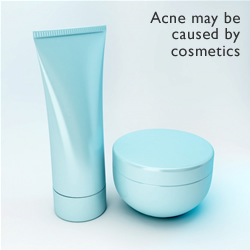Cosmetic-Induced Acne

Cosmetic-induced acne is, as the name suggests, a clinical type of acne caused by the use, or overuse, of certain types of cosmetics and skin care products. Moisturising creams or other oily skin care products can, when used too frequently or in large quantities, give rise to skin with a greasy covering layer. This build up of oil-based residues tends to block the hair follicles, which encourages the proliferation of bacteria and provides the ideal conditions under which comedones develop. Other cosmetics, particularly those used to hide blemishes, or 'cover up' makeup to mask other skin conditions, cause acne by a process which involves blockage of the hair follicles, but without a greasy component. A few cosmetics contain free fatty acids and so are directly comedogenic, i.e. they cause spots to develop even in the absence of other acne promoting factors. Typically it is amongst the cheaper cosmetics, particularly those produced in developing countries, and home made skin care products that one finds products whose effect is to cause acne directly.
Diagnosis of Cosmetic-Induced Acne
The diagnosis of cosmetic-induced acne depends on clinical examination of the spots - usually localised, well demarcated patches of acne limited to the areas of cosmetic application - and exhaustive questioning regarding the type and quantities of cosmetics used and the person's skin care regime.
Cosmetic-Induced Acne Treatment
Treatment of acne caused by cosmetics relies first on weaning the person off the use of inappropriate or damaging cosmetic and skin care products, and then regularising them on a suitable skin care regime. Acne treatment may also be required, dependent on the extent and severity of the condition.